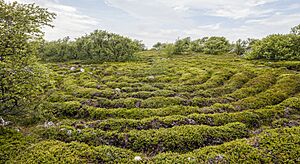Stone labyrinths of Bolshoi Zayatsky Island facts for kids
The stone labyrinths of Bolshoi Zayatsky Island are a fascinating group of 13 or 14 labyrinths found on Bolshoy Zayatsky Island. This island is part of the Solovetsky Islands in Arkhangelsk Oblast, Russia. These ancient stone puzzles are very old, possibly around 2,500 years old! Researchers from St. Petersburg believe this based on how the labyrinths are lined up, what they might have been used for in rituals, and how the sun's position changed over time.
Besides the labyrinths, Bolshoi Zayatsky Island has over 850 piles of rocks. There are also other interesting stone shapes, like one that looks like a sun with rays. All the labyrinths are found in a small area of about 0.4 square kilometers on the western side of the island. Another huge collection of stone structures is on Sopka Hill, in the eastern part of the island, but it doesn't have any labyrinths.
Across all the Solovetsky Islands, there are 35 labyrinths in total. Locals call them vavilons, which means "Babylons." All of them were built using local rocks. When people dug into some of the stone piles, they found pieces of bones.
What Do These Labyrinths Look Like?
These labyrinths are quite large, ranging from 6 to 25.4 meters across. They are mostly made from round stones, about 30 to 40 centimeters wide, placed in a line. The lines of stones twist around like a spiral. Many of them have two spirals that fit into each other, almost like "two snakes with their heads looking at each other in the middle." Sometimes, along the spiral, there are thicker or wider piles of stones. The ends of the spirals are also wider.
Most of the time, you enter these labyrinths from the south side. However, some entrances can be found on the southwest, east, or west sides. There are five different styles of these labyrinths, but each one has only one opening that works for both going in and coming out.
Why Were These Labyrinths Built?
The exact reason for these stone structures is still a mystery. One idea is that they might have been a special boundary between the living world and the spirit world. People might have used the labyrinths for important rituals to help the souls of people who had died move on to another place. Another idea is that these stone patterns could have been models for complicated fishing traps.
Images for kids








